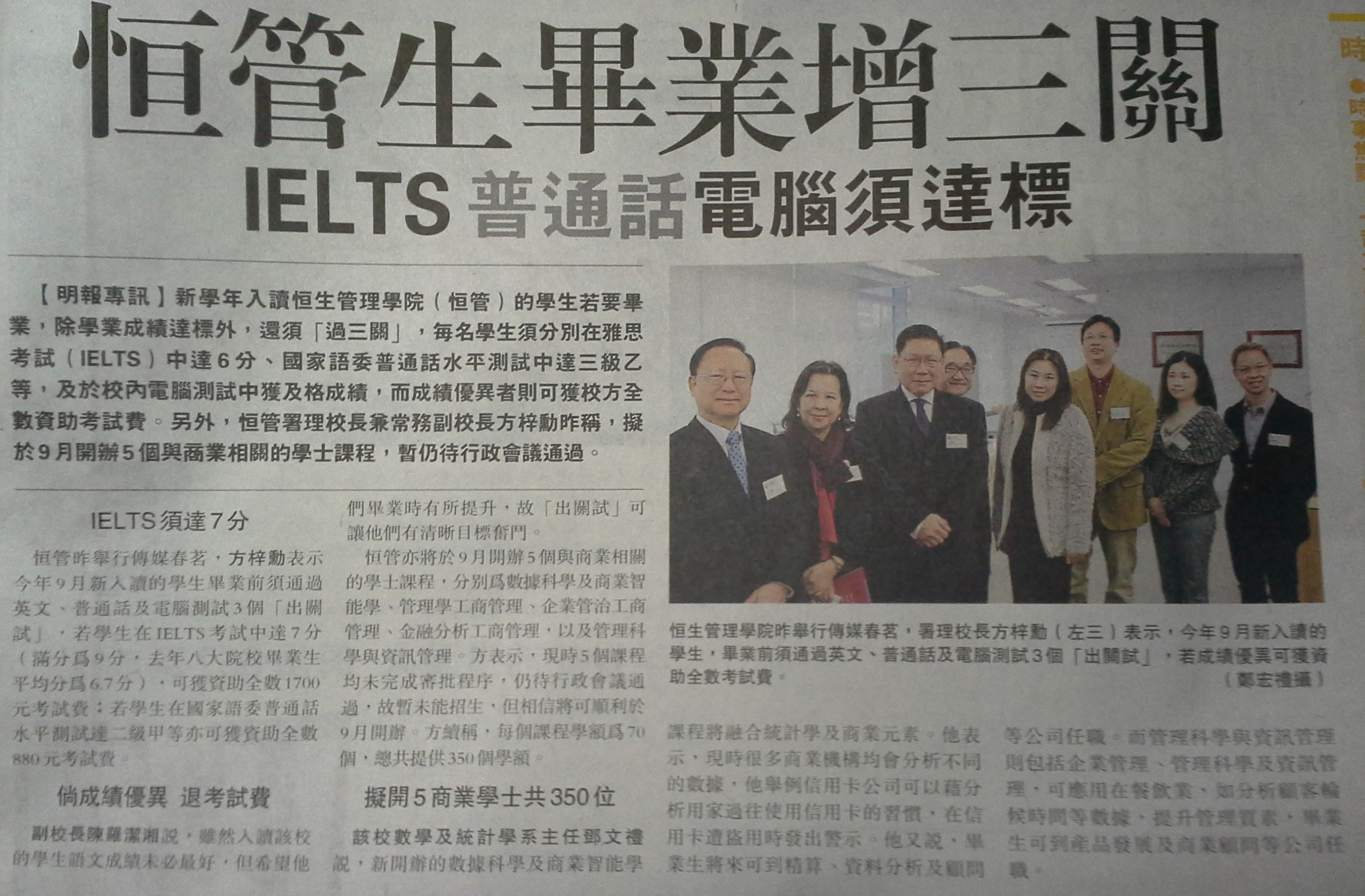
數據科學及商業智能學課程 各行各業大趨勢 職場無往不利 (2014年8月6日)
恒生管理學院 數據應用人才 求才若渴 (2014年7月14日)
The Best Jobs of 2014: 1. Mathematician; 3. Statistician; 4. Actuary (April, 2014)
Harvard Business Review - Data Scientist: The Sexiest Job of the 21st Century (October 2012)
以上的內連結只在IE有效.
明報 2014年9月1日
| 全面培育數據科學專才 |
 |
| 回頂頁 |
數據科學及商業智能學課程 各行各業大趨勢職場無往不利 |
||
|
|
||
|
在資訊爆炸的年代,全球都由數據主導, 有見及此,恒生管理學院(恒管)今年開辦全新的「
一個課程無限可能
課程名稱看似複雜,但基本概念卻不難理解,恒管數 學及統計學系系主任鄧文禮教授解釋:
「例如書店可透過資料庫,分析潛在讀者的閱讀習慣, 專業教學彈性選科 鄧文禮教授指, 「課程專業」及「商學教育」部分各佔課程內容約20%, 其中, 「官方統計及道德概論」正是其他大專院校較少開辦的科目,
人才需求與日俱增
同時,恒管設有應用統計電腦實驗室, 根據研究資料顯示,美國於2018 年數據科學行業將短缺近19
萬人,加上畢業生可將相關技術應用於不同工種,行業前景理想。 數據科學及商業智能學課程 電話:3963 5004 電郵:dsbi@hsmc.edu.hk 網址:www.hsmc.edu.hk/dsbi
SAS 營運總經理華偉鋒先生:「課程完備全面,達培訓專才目的。」 SAS 營運總經理華偉鋒表示,商業數據量近10 年大幅增長,如能從中分析有用數據將有利企業掌握市場趨勢, 他認為,從業員必須具備數據管理技術和商業智慧, |
 |
| 回頂頁 |
經濟日報 2014年8月2日
恒管辦數據科學課程 迎「大數據」 |
||
|
|
||
|
【本報訊】在現今智能化的年代,社會每日產生大量數據, 恒生管理學院新學年就首辦數據科學及商業智能學課程, 社交網站、八達通卡、信用卡等都載有不少使用者習慣的有用數據。 分析消費習慣 數據定策略 將開辦數據科學及商業智能學(榮譽)理學士課程的恒生管理學院, 而恒管新學年首辦的數據科學及商業智能學(榮譽)理學士課程, 鄧又以美國為例,指他曾在當地當3年生物醫療研究員, 但湛家揚亦指,本港在商業智能的發展較落後, 商業智能人才 需3類技術 湛補充,商業智能的人才需擁有三方面的技術,包括電腦科學, |
 |
| 回頂頁 |
星島日報 2014年7月14日
 |
| 回頂頁 |
CareerCast 2014 年4月
|
Jobs Rated 2014: Ranking 200 Jobs
From Best To Worst |
|
Every year since 1988, the Jobs Rated report has measured different careers through a variety of metrics. Understanding the challenges and rewards of a career is especially important given how vested we are in our work life.
The U.S. Bureau of Labor Statistics (BLS) estimates the average American employee spends more than two-thirds of his or her day at work or on work-related activities.
Of course, much can change in the rankings of our Jobs Rated report over 26 years. Consider publication editor. Just 12 years ago, it ranked No. 31 overall. It checks in at 139 in this year's Jobs Rated report.
Technology has a profound impact on the demand, compensation and environment of a job. It's also a career path all its own—and a rewarding one, as evident by the ranking of IT jobs in the 2014 Jobs Rated report.
Cultural shifts are also crucial to the job market. The institution of the Affordable Care Act and an aging Baby Boom generation contribute to growing demand in the healthcare field, and that is reflected in the favorable ranking of many jobs in the industry.
The findings we present here are more than just curiosities. Unlike many other facets of life, the jobs we work at are choices we make - ones we can stick with or change. Therefore, the “measure” of a job can tell us a lot about the quality of our lives.
No two work experiences are guaranteed to be alike, and different career paths cater to unique skills and interests. Ultimately, only you can determine the best job for your abilities and passions. However, the Jobs Rated report exists as a road map that will you determine the career field that is right for you.
1. Mathematician
Applies mathematical theories and formulas to teach or solve problems in a business, educational, or industrial climate.
2. University Professor (Tenured)
Instructs students in a wide variety of academic and vocational subjects beyond the high school level. They also conduct research and publish scholarly papers and books.
3. Statistician
Tabulates, analyzes, and interprets the numeric results of experiments and surveys.
4. Actuary
Interprets statistics to determine probabilities of accidents, sickness, and death, and loss of property from theft and natural disasters.
|
| 原文 | 回頂頁 |
明報 2014年2月19日
|
擬開5 商業學士共350 位 ... 該校數學及統計學系主任鄧文禮說, 新開辦的數據科學及商業智能學課程將 融合統計學及商業元素。他表示,現時很多商業機構均會分析不同的數據,他舉例信用卡公司可以藉分析用家過往使用信用卡的習慣,在信用卡遭盜用時發出警示。 他又說,畢業生將來可到精算、資料分析及顧問等公司任職。而管理科學與資訊管理則包括企業管理、管理科學及資訊管理,可應用在餐飲業,如分析顧客輪候時間 等數據,提升管理質素,畢業生可到產品發展及商業顧問等公司任職。 |
 |
| 原文 | 回頂頁 |
Yahoo財經 2013年8 月8日
 |
|
蘇教授論經濟-得商業智能得 天下 商業智能(Business Intelligence)是近年來冒起很快的一種商業數據分析應用,嚴格來說,商業智能並不是一個獨立的商業應用,而是利用數據庫、在線分析處理 (One-Line Analytical Processing,OLAP)、數據挖掘等技術來分析數據,並將得出來的資訊,用來給管理人員作出商業決策。現代管理決策很吃重訊息和資訊,商業智能 提供了一個平台,讓一些獨立的數據分析技術可以結合在一起,從而為管理人員提供了有用的數據作決策參考。
和傳統的管理資訊系統不一樣,商業智能強調的是處理資料上的彈性。企業一般要得到決策所需的資訊,現時大多要依賴資訊科 技,良好而完備的管理資訊系統就顯得重要,這是一般人對資料系統的理解。儘管管理資訊系統可以滿足企業資訊上的要求,但管理資訊系統的一個缺點,是其應用 上的彈性較低,管理資訊系統內提供的數據報表,需要依靠程式撰寫,當外在環境改變而帶來新的數據要求時,管理資訊系統內的程式就要更新或是重寫,這對企業 來說是局限了其資料上的應用。
商業智能的設計反之是以彈性見稱,企業若是有新的資訊要求,企業不需要以新的程式撰寫來獲得,而是原有數據處理參數已有準 備,可以讓用家加上自己的要求參數,這大大增加了資訊的速度和使用上的方便。要強調的是,商業智能並非取代程式撰寫,事實上商業智能在使用上很依賴電腦的 應用,電腦程式更是不可或缺,只是在應用層面上,商業智能以彈性處理的介面,省卻了死板的程式設計和日後系統的保養成本。
商業智能的發展和數據有扯不開的關係,所以商業智能往往是一門結合數據處理和分析的學科,需要的是數據分析和電腦技術。在 大數據時代的來臨,資訊變得更快和更多,傳統的管理資訊系統便顯得不足夠,若是企業能夠利用商業智能,使之增加企業的決策能力和質素,會是企業成敗的一個 重要因素。
|
| 原文 | 回頂頁 |
Yahoo財經 2013年8月6日
 |
|
蘇教授論經濟-大數據年代 現代商業管理著重分析,對數據的處理、資訊應用尤其重視,以前的數據分析主要 集中在自家公司的營運資料,這個方向至今仍是主流。這種以營運數據為分析的好處,就是在挖掘出客戶的消費行為,從而得出客戶的行為偏好,讓企業可以集中銷 售策略。然而,隨著電腦分析的發展、數學模式的應用、和意識到多維數據的重要,數據分析已不再局限在營運資料,現在我們已進入「大數據」(Big Data)的年代。
大數據並非只代表大量的數據,在大數據的定義上,我們通常用三V來代表:高數量(High Volume)、髙速度(High Velocity)、高差異(High Variety),這三個V生動地描述了大數據的特點,就是大數據除了是量的考慮之外,還有速度上的元素,再加上多樣化的特質,也就是說傳統的數據分析已 不能針對現代的數據要求。
第一個V的大量數據可以容易理解,因為資料儲存的技術和成本大幅降低,再加上電腦技術的進步,企業自然可以透過數學模型和 電腦模擬,去處理大量數據。第二個V是指數據的速度,科技進步是數據快速流通的重要原因,資料可以在產生的當兒便輸進數據庫,這大大加強了數據庫更新的速 度。第三個V是多樣化,也就是說數據分析已不再局限單一範圍,因為很多看似不相關的數據,彼此其實有著連繫。從前由於數據分散和科技上的限制,要進行大規 模和大範圍的數據分析並不容易,所以第三個V儘管被人意識到其重要性,但還是到了近年才在大數據的概念上得到真正的重視。大數據發展快速,最近有人認為三 個V已不足夠描述大數據,在三個V的基礎下加上第四個V真實性(Veracity),可見大數據的發展和特質。
商業上大數據的應用有很大的潛力,因為大數據提供了以前沒有觸及的方向。可是大數據的挖掘不免涉及數據道德這個課題,不少 人擔心大數據可以變成侵犯個人私隱的途徑,尤其是政府機器在大數據的角色,更是廣受人關注,假如政府濫用數據來掌握人民的私隱,後果可以是驚人的。
|
| 原文 | 回頂頁 |
Harvard Business Review 2012年10月
|
Data Scientist: The Sexiest Job of the 21st Century |
|
When Jonathan Goldman arrived for work in June 2006 at
LinkedIn, the business networking site, the place still felt like a
start-up. The company had just under 8 million accounts, and the number
was growing quickly as existing members invited their friends and
colleagues to join. But users weren’t seeking out connections with the
people who were already on the site at the rate executives had
expected. Something was apparently missing in the social experience. As
one LinkedIn manager put it, “It was like arriving at a conference
reception and realizing you don’t know anyone. So you just stand in the
corner sipping your drink—and you probably leave early.”
|
| 原文 | 回頂頁 |